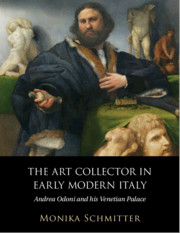Refine search
Actions for selected content:
4 results
Chapter Seven - The Afterlife
- from Part II
-
- Book:
- Reforming Art in Renaissance Venice
- Published online:
- 24 January 2025
- Print publication:
- 13 February 2025, pp 324-361
-
- Chapter
- Export citation
Chapter 5 - The Mirrors of Venus
-
- Book:
- The Mirror of Art
- Published online:
- 28 November 2024
- Print publication:
- 28 November 2024, pp 269-354
-
- Chapter
- Export citation
4 - Prudence
- from PART IV - THE ETHOS OF MODERATION
-
- Book:
- Why Not Moderation?
- Published online:
- 12 October 2023
- Print publication:
- 12 October 2023, pp 175-182
-
- Chapter
- Export citation

The Art Collector in Early Modern Italy
- Andrea Odoni and his Venetian Palace
-
- Published online:
- 23 August 2021
- Print publication:
- 23 September 2021
